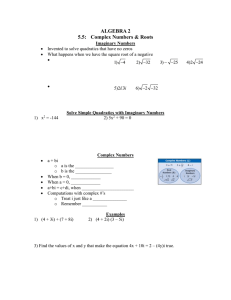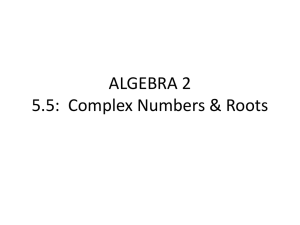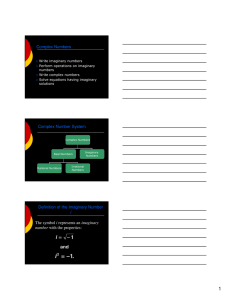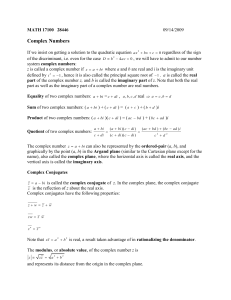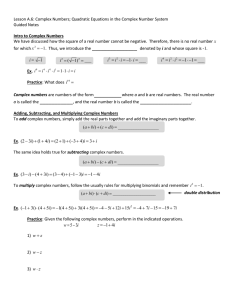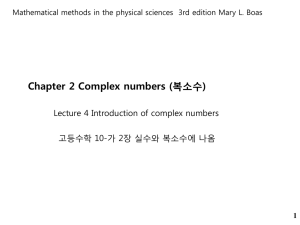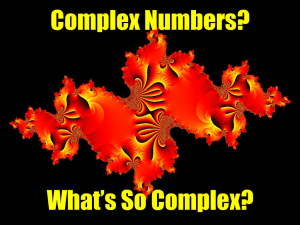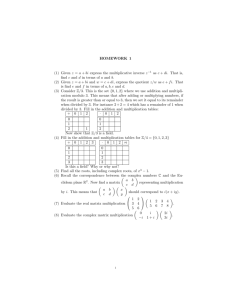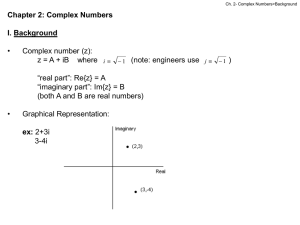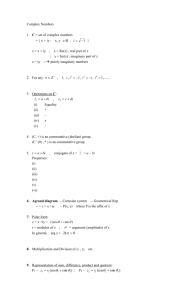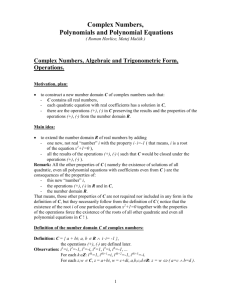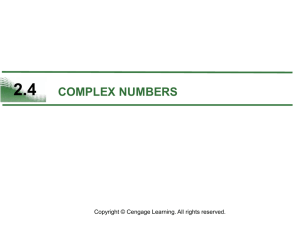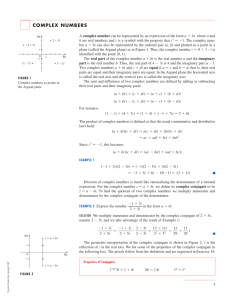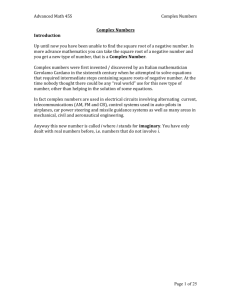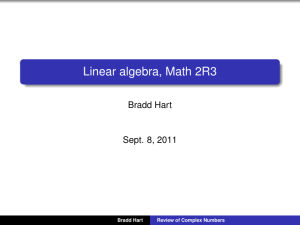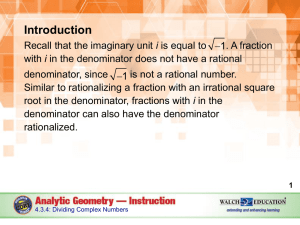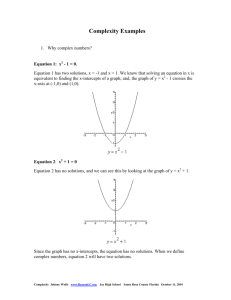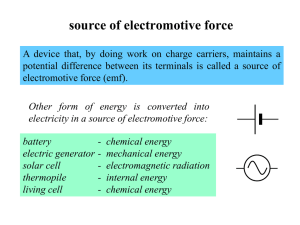Ch 8 Complex Numbers, Polar Equations, and Parametric Equations
advertisement
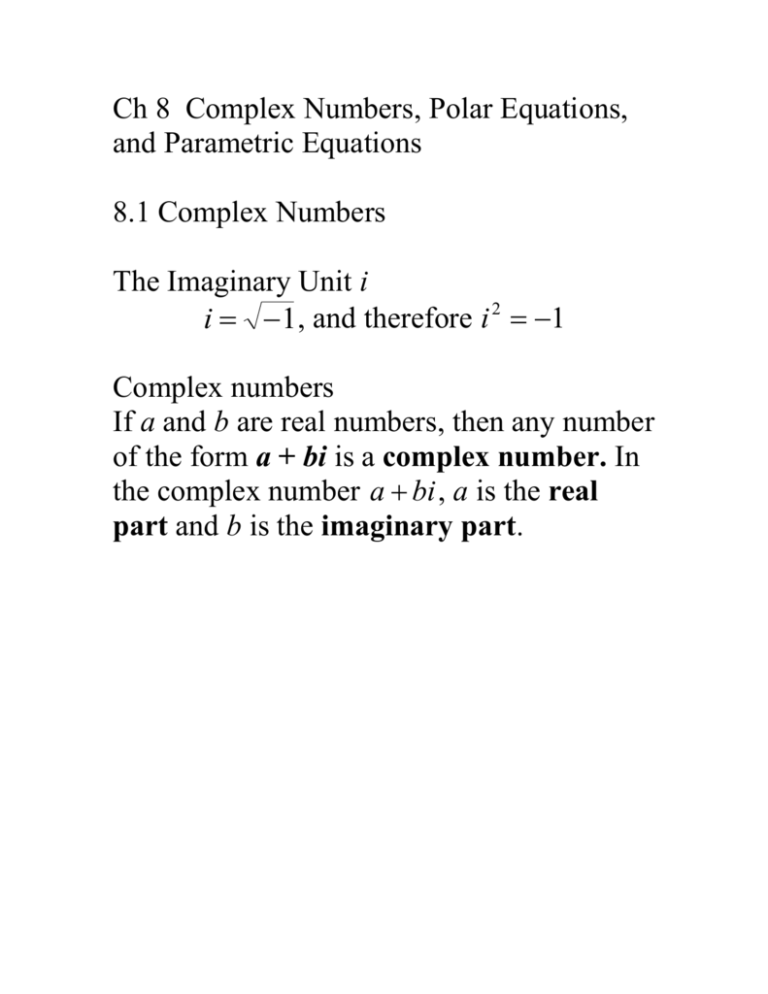
Ch 8 Complex Numbers, Polar Equations, and Parametric Equations 8.1 Complex Numbers The Imaginary Unit i i 1, and therefore i 2 1 Complex numbers If a and b are real numbers, then any number of the form a + bi is a complex number. In the complex number a bi , a is the real part and b is the imaginary part. Complex # s Real# s a bi, b 0 imaginary # s If a 0 , then a i a. Write as the product of a real number and i, using the definition of a 16 70 48 Solve x 2 9 Solve x 2 24 0 Solve 9 x 2 5 6 x When working with negative radicands, use the definition a i a before using any of the other rules for radicals. 7 7 6 10 20 2 48 24 8 128 4 Addition and Subtraction of Complex Numbers a bi c di a c b d i a bi c di a c b d i 3 4i 2 6i 4 3i 6 7i 1 6i 8 3i 7 3i Multiplication of Complex Numbers a bi c di ac bd ad bc i 2 3i 3 4i 4 3i 2 6 5i 6 5i a bi a bi To find the quotient of two complex numbers in standard form, multiply numerator and denominator by the complex conjugate of the denominator. 3 2i 5i 3 i Powers of i i15 i 203 i 3 8.2 Trigonometric (Polar) Form of Complex Numbers The Complex Plane and Vector Representation Horizontal axis: real axis Vertical axis: imaginary axis 2 3i Each complex number a bi determines a unique position vector with initial point 0,0 and terminal point a, b . 4 i 1 3i 6 2i 4 3i Relationships Among x, y, r, and θ. x r cos y r sin y tan , x 0 r x2 y 2 x Trigonometric (Polar) Form of a Complex # The expression r cos i sin is the trigonometric form (or polar form) of the complex number x yi . The number r is the absolute value (or modulus) of x yi , and θ is the argument of x yi . The expression cos i sin is sometimes abbreviated cis θ. Write 2cos 300 i sin 300 in rectangular form. Converting From Rectangular to Trigonometric Form 1 Sketch a graph of the number x yi in the complex plane. 2 Find r by using the equation r x 2 y 2 3 Find θ by using the equation y tan , x 0, choosing the quadrant x indicated in Step 1. Write 3 i in trigonometric form. Write –3i in trigonometric form. Write 6cos115 i sin 115 in rectangular form. Write 5 4i in trigonometric form. The fractal called the Julia set is shown here. To determine if a complex number z a bi is in the Julia set, perform the following sequence of calculations. z 1, z 1 1, 2 2 2 z 2 1 1 1, 2 2 If the absolute values of any of the resulting complex numbers exceed 2, then the complex number z is not in the Julia set. Otherwise z is part of this set and the point (a, b) should be shaded in the graph. z 0 0i z 1 1i 8.3 The Product and Quotient Theorems 1 i 3 2 3 2i Product Theorem If r1 cos 1 i sin 1 and r2 cos 2 i sin 2 are any two complex numbers, then: r1 cos 1 i sin 1 r2 cos 2 i sin 2 r1r2 cos1 2 i sin 1 2 or r1cis1 r2cis2 r1r2cis1 2 Find 3cos 45 i sin 452cos 135 i sin 135 1 i 3 Find 2 3 2i Quotient Theorem If r1 cos 1 i sin 1 and r2 cos 2 i sin 2 are any two complex numbers, where r2 cos 2 i sin 2 0 then: r1 cos 1 i sin 1 r1 cos1 2 i sin(1 2 r2 cos 2 i sin 2 r2 or r1 cis1 r1 cis1 2 r2 cis 2 r2 Find 10cis 60 5cis150 Find 9.3cis125.22.7cis 49.8 3 3 10.42 cos i sin 4 4 Find 5.21 cos i sin 5 5 8.4 De Moivre’s Theorem; Powers and Roots of Complex Numbers r cos i sin 2 r cos i sin 2 r cos i sin If r cos i sin is a complex number, and if n is any real number, then: n r cos i sin r n cos n i sin n Find 1 i 3 8 nth Root For a positive integer n, the complex number a bi is an nth root of the complex number n x yi if a bi x yi r cos i sin 3 8cos135 i sin 135 nth Root Theorem If n is any positive integer, r is a positive real number, and θ is in degrees, then the nonzero complex number r cos i sin has exactly n distinct nth roots, given by 360 k n r cos i sin where or n 360 k , k 1,2,3,, n 1. If θ is in n n 2k 2k radians, then or . n n n Find the two square roots of 4i. Find all fourth roots of 8 8i 3 Find all complex number solutions of x 5 1 0 8.5 Polar Equations and Graphs The polar coordinate system is based on a point, called the pole, and a ray, called the polar axis. Point P has rectangular coordinates x, y . Point P can also be located by giving the directed angle θ from the positive x-axis to ray OP and the directed distance r from the pole to point P. The polar coordinates of point P are r , . From section 8.2, Relationships Among x, y, r, and θ. x r cos y r sin y 2 2 tan , x 0 r x y x Plot and convert to rectangular coordinates. P2,30 2 Q 4, 3 R 5, 4 Give 3 other pairs of polar coordinates for P3,140 Determine 2 pairs of polar coordinates for 1,1 Polar equations ax by c x2 y 2 a2 Give polar equation and sketch graph y x 3 x2 y 2 4 Graphing a polar equation (cardioid) r 1 cos cos θ θ r 1 cos Graphing a polar equation (rose) r 3 cos 2 cos 2θ θ 2θ r 3 cos 2 Graphing a polar equation (lemniscate) r 2 cos 2 cos 2θ θ 2θ r cos 2 Graphing a polar equation (Spiral of Archimedes) r 2 (in radians) θ r 2 4 Convert r to rectangular 1 sin coordinates and graph. 8.6 Parametric Equations, Graphs, and Applications Parametric Equations of a Plane Curve A plane curve is a set of points x, y , such that x f t , y g t , and f and g are both defined on an interval I. The equations x f t and y g t are parametric equations with parameter t. Let x t 2 and y 2t 3 for t in 3,3. Graph the set of ordered pairs x, y . Find a rectangular equation for x t 2 and y 2t 3 for t in 3,3. Graph the plane curve defined by x 2 sin t and y 3 cos t , t 0,2 Give two parametric representations for the 2 equation of the parabola y x 2 1 Graph the cycloid x t sin t , y 1 cos t , t 0,2 Applications of Parametric Equations If a ball is thrown with a velocity v feet/sec at angle θ with the horizontal, its flight can be modeled by x v cos t and y v sin t 16t 2 h , where t in sec, h is initial height. Three golf balls are hit into the air at 132 ft/sec at angles of 30°, 50°, and 70°. Which ball travels further, and which ball reaches greatest height? Jack Lukas launches a small rocket from a table that is 3.36 ft above ground. Initial velocity is 64 ft/sec, and it is launched at an angle of 30°. Find the rectangular equation that models its path. Determine total flight time and horizontal distance traversed.
